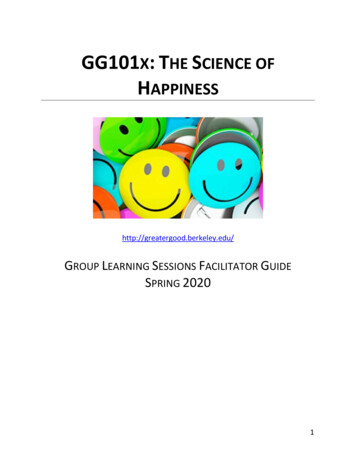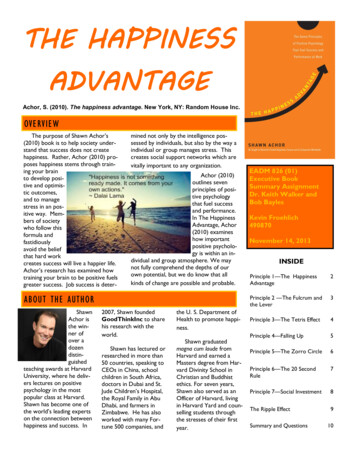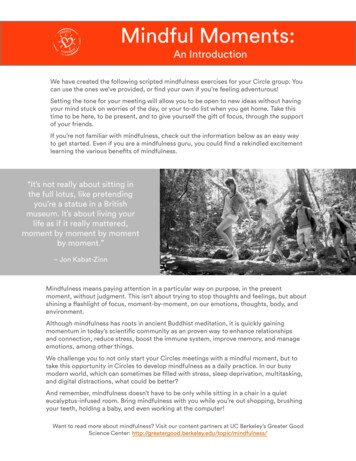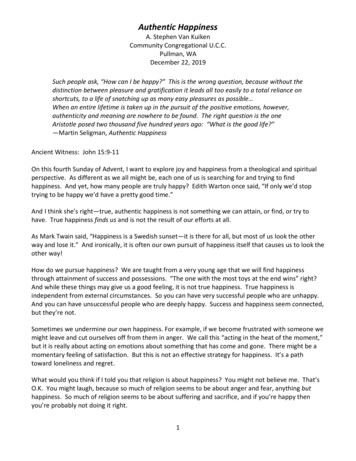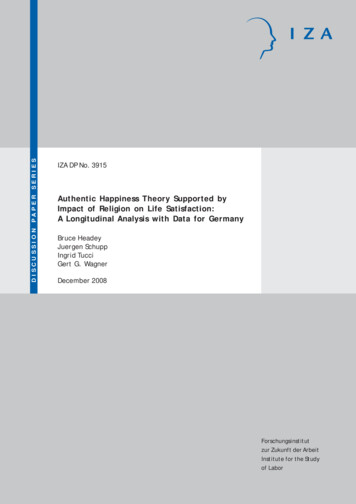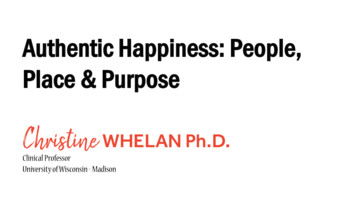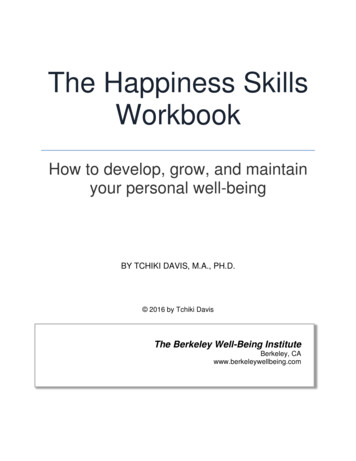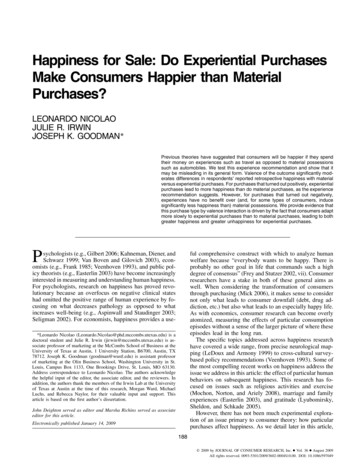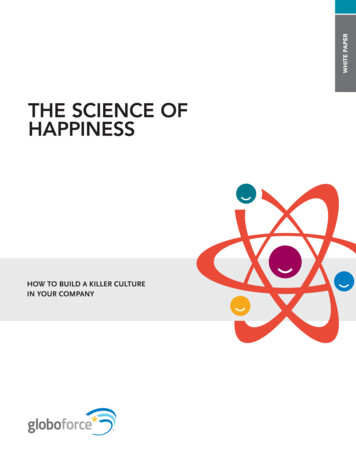
Transcription
WHITE PAPERThe science ofhappinessHow to Build A killer culturein your company
The Science of Happiness // 2Every company - whether it is trying to build one or not - has a culture.And Culture matters. A great culture can make the critical difference betweenorganizational success and dismal failure. It impacts just about every business metricwe have, from customer service to productivity to profitability. It is the key to retentionbecause employees don’t want to leave a great culture. It is the key to recruitmentbecause applicants are clamoring to get in. Intel, whichis renowned for its iconic culture, has a turnover rate ofonly 2% and Google gets an estimated 7,000 unsolicitedIntel, which is renowned for itsapplications for jobs every day.iconic culture, has a turnover rateBut let’s face it, the culture we have isn’t always theof only 2% and Google getsculture we want. What if your culture needs some help?an estimated 7,000 unsolicitedOr a lot of help? How can companies that might lack theapplications for jobs every day.resources of a Google still create a magnetic culture?The short answer is by concentrating on employee happiness.At this point, you might be thinking: “Wait employee happiness? Shouldn’t culture startwith an all-hands meeting with the CEO or with free snacks in the break room?”HR leaders encounter a lot of advice about how to manage culture—to increaseengagement, decrease turnover, and drive recruitment. But when it comes to creating aculture employees love and don’t want to leave, employee happiness is the metric thatreally matters. In this paper, we will explore why.
The Science of Happiness // 3The Secret Sauceof Company CultureToo often, we think about culture in one of two ways:py Culture is the sum of your perksHap Culture is dictated from the topHappyemA good culture may have some perks, and it certainly needsinvolvement of execs, but neither alone will get you a great culture.ployerees a10X0It is tempting for many to think of company culture in terms offringe benefits— like funky offices, onsite massages and freesoda. These outward trappings of companies with great cultureare often what we think of when we think of Great Places toWork . But perks grow from culture, not the other way around.Perks are just the manifestation of what makes a particular groupof people (your employees) happy.employe e s ar e85%t h emoreat theirworkLikewise, leaders tend to see culture in terms of things they can do—like setting goalsand core values. Their participation is an important part of the picture, and trustin leaders is one of the key drivers of engagement, but execs cannot dictate aless likelygreat culture. They can only lay the groundwork for a great culture to take hold.to takesick leaveIt is your employees who control your culture. When they are happy, it thrives. Ifthey are stomping around complaining well, your culture probably stinks—nomatter how great your mission statement is or how free your dry cleaning.Happy employees are what make a culture great.How do we know this? An increasing body of research, for one thing. Consider this recentresearch posted by the Wall Street Journal and the iOpener Institute1. HappyH ap pyememployees:pl50%are Spend 65% more time feeling energizedees Believe they are achieving their potential 2x as muchoy Stay twice as long in their jobs as their least happy colleagues Are 58% more likely to go out of the way to help their colleagues Identify 98% more strongly with the values of their organization Are 186% more likely to recommend their organization to a friendUnlike culture itself, we have hard numbers on the science of employeehappiness and how to directly increase it. It all leads to one conclusion:Concentrating your efforts on making employees happy is the most direct andpowerful way to impact your organizational culture.stronger senseof gettingthings done
The Science of Happiness // 4don’t worry.Be happy.So how exactly do we go about creating this happy workforce?As an HR exec or senior leader, you may have believed a world-class culture like Google’sor JetBlue’s or Intuit’s is beyond your company’s grasp. Great culture and happy employeesare often equated with innovation and risk-taking and gobs of money to spend. And ofcourse, not every company is a glamorous consumer brand or selling a feel-good product.Luckily, happy employees are never entirely beyond any company’s grasp. It’s as simpleas discovering what workers will respond to and doing it. Sometimes this may be a policy,sometimes a perk, or sometimes it is just simple common sense. Some methods will beunique to your company, your industry and your employees.Others are universal.ALIGNMENThese universal drivers of employee happiness fall intothree categories: alignment, positivity, and progress.TIT YIVPRO GRESSEverything employees need—and everythingyou need to build a killer culture that will attractand keep the best talent—rolls up into one ofthese three things.IP OSTBy pursuing them, you can create a groundswell of happiness that will grow your culturefrom the bottom up.
The Science of Happiness // 5Get into alignmentAlignment is the first goal for employee happiness. It means you must ensure not only a goodperson-job fit, but a good person-company fit. There must be a fundamental compatibilitybetween the employee’s vision, goals and values, and those of the organization.Allowing employees to see how they fit into the larger picture activates their sense ofbelonging, effectiveness and meaning. “New research shows there is a strong correlationbetween happiness and meaning,” says Jennifer Aaker from the Stanford Graduate Schoolof Business. “In fact, having a meaningful impact on the world aroundyou is actually a better predictor of happiness than many other thingsyou think will make you happy.”2Great Ways toBuild alignment1. Pay closer attentionto job-person fit2. Fire people who don’tfit your culture3. H elp employees find greatermeaning in your values4. S how workers howyour company fits intoa bigger picture5. Cultivate more trust andflexibility into your policiesMeaning is more important now than ever. According to a 2012 studyconducted by Kelly OCG, many employees feel directionless anddisposable—with just 44% of employeesworldwide reporting feeling valued by theirPeople who focused on theemployers, and only 48% saying that their3current job provides them with meaning.meaning and purpose in theirA study conducted by researchers at theUniversity of Alberta found that people whofocused on the meaning and purpose in theirwork experienced a 60% drop in absenteeismand a 75% reduction in turnover.4work experienced a 60%drop in absenteeism and a75% reduction in turnover.Feedback is another important element of alignment. “Happiness is adaily journey,” says James Key Lim, an early leader at Zappos. In a recentFast Company article, Lim cited co-owned values as critical, along withregular and ongoing feedback to ensure that everyone stays aligned withthem. Aligning people with their passions both on the job and in the restof their lives will cultivate happier employees, says Lim, and feedback isa key way to reinforce this, daily.And of course we must not forget flexibility. When employees are able align their workand personal lives, they are consistently happier. Each year, CareerBliss looks at thecompanies with the biggest leaps in employee happiness. Work-life balance, saysCareerBliss CEO Heidi Golledge, is a key factor in determining employee happiness.“Having programs that allow managers to offer employees flexibility can be a keycomponent in creating a happy work environment.”
The Science of Happiness // 6Accentuate the positiveHappy employees are positive employees. They have what scientists refer to as a positive“affect” or mood, which leads to an overall positive climate for companies. One 2011 studyat a Fortune 500 call center found that reps who were in bad moods had worse customerservice, needed more breaks, and saw a more than 10% decline in their productivity. 5Great Ways toBuild positivityHappy employees also have high reserves of PsyCap, or psychologicalcapital. Researchers report significant relationships between high levelsof PsyCap and: A rise in desirable employee attitudes A rise in desirable employee behaviors High marks in multiple measures of performance1. Broadcast personaland team successes A decline in undesirable employee attitudes2. Offer fast, positive feedback3. Open up multidirectionalcommunication lines4. Offer resources andemotional support5. Encourage employeesto express gratitude A fall in undesirable employee behaviors.6Researchers of PsyCap have seen big boosts in positivity by encouragingpeople to show gratitude. A study at Kent State examined the effectsof writing letters of gratitude significantly increased happines and lifesatisfaction, and alleviated depressive symptoms.”7Encouraging gratitude and appreciation—and recognition is the idealvehicle for this— can also pay dividends in the workplace. In our Spring2013 Globoforce Workforce Mood Tracker report, we found that whenpeople were enabled to recognize peers for good work, they were 107%more likely to identify themselves as highly engaged.Overall emphasis on positive feedback is another critical element of employee happiness. Inat same Mood Tracker report, we found that 89% of employees prefer to be told what theyare doing right, rather than being told what they are doing wrong. In our SHRM GloboforceSpring 2013 Report, 94% HR leaders said positive feedback has a greater impact onimproving employee performance.Says Gretchen Rubin, author of the New York Times best-seller The Happiness Project:“A workplace is far likelier to be a happy place when policies are in place to ensure thatpeople regularly get acknowledgement and praise for a job well done, and where peoplefeel that their happiness at work matters to their employers.”8
Progress is the third and final way to develop happy employees. We all want to feel like we aregetting somewhere and accomplishing something in our careers and in our lives. In surveyafter survey, employees consistently cite career development opportunities as a top concern.Aon Hewitt’s 2012 Global Engagement Report found that concern for career opportunitiesis the top global driver of employee engagement and recommends that employers workto create employee growth opportunities:Great Ways toBuild pRogress1. Set clear, measurableand achievableorganizational goals2. Show employees how theyfit into the bigger picture3. Offer training for masteryof new and existing skills4. Respect individualism5. Reward excellenceand effortEmployees are increasingly looking to their current employers for jobenrichment opportunities Employers should develop more creativeor less traditional growth opportunities and help employeesre-navigate expectations around development thatsupports business needs—lateral moves, specialassignments, cross-functional training, etc.According to Career Bliss’ CEO Heidi Gollege:“We see career advancement programs have abig impact on overall employee happiness. Oftenemployees will take a job for a lower salary if thecompany provides a comprehensive program andmentorship programs, which will help grow theircareer. Employees want to learn, develop andsustain a successful career path.”Development and progress is defined differentlyfor each employee, so this goal relies on managerstaking the time to discuss employees’ individualgoals with them, as well as companies providing growthopportunities.Another important piece of the puzzle is to identify those employeeswho are your ‘cultural energizers’—who drive the progress of your organization andinfluence their peers. Finding and growing these important employees—whether theyare meant for the management track or simply important single contributors, is a key wayto keep your culture on track.And finally, it is mandatory to reward employees for their progress and achievements.Michael Civello at Plum Benefits sums it up well: “Increasing employee happiness is basedon a strong foundation of effective and proactive communication and recognition, alongwith a commitment to facilitating relationship-building across all levels and departments.”9The Science of Happiness // 7Keep the wheels ofprogress in motion
The Science of Happiness // 8How to get rollingEmployee happiness is not a cakewalk. According to the Conference Board, it is in thetank. Their research shows that worker happiness has fallen every year for the last 25years.10 Companies need to put into place programs that draw out these principles ofalignment, positivity, and progress that can move the needle for happinessand build a killer culture.Research from the conferenceboard shows that workerhappiness has fallen everyyear for the last 25 yearsA strategic recognition program is a great start on achieving all three ofthese objectives—offering a way for employees to better understand andpractice company values, offer continuous positive feedback, appreciate andbe appreciated and a way to be rewarded for the progress they make towardtheir goals.
tp://www.kellyocg.com/Knowledge/Whitepaper Content/Happiness and Meaning at Work White .cfm?newsitem ompany-can-do-about-itContact us to learn more about what
research posted by the Wall Street Journal and the iOpener Institute 1. Happy employees: . you think will make you happy.”2 Meaning is more important now than ever. According to a 2012 study conducted by Kelly OCG, many employees feel directionless and disposable—with just 44% of employees worldwide reporting feeling valued by their employers, and only 48% saying that their
